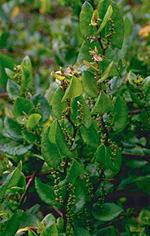 |
This is a large family, mostly from the temperate parts of the Northern Hemisphere but with some species in southern temperate areas and a few in the tropics. In Australia, most species are associated with seasonally wet or marshy areas, from the coasts to the arid interior; they only rarely occur in closed forests or shady sites. Some species are serious weeds of pastures and gardens.
Characteristic features of the family Polygonaceae in Australia include: - herbs or shrubs, occasionally twining, with rosetted or cauline leaves which are often hastate or sagittate (arrow-head shaped) at the base, or sometimes the leaves much reduced
- stipules present and characteristically forming a dry, membranous sheath (ochrea) around the stem at the base of the petiole
- flowers small, greenish, white or pink, regular, bisexual, with perianth parts in one whorl (or if in 2 whorls then the parts all similar)
- ovary superior with one ovule, developing into a usually angular, grain-like nutlet
Description
Evergreen or semi-deciduous shrubs, or woody or herbaceous vines
climbing by twining stems, or annual, biennial or perennial terrestrial
herbs, or aquatic herbs rooted in the substrate with their leaves emergent.
Perennation by taproots or crowns. Vegetative reproduction absent or by
rhizomes or root suckers. Leaves sometimes ±absent. Stems unarmed,
or rarely with thorns or spines arising from the leaf axils; nodes conspicuously
swollen or not; internodes solid, spongy, pithy or hollow, terete or angular.
Extra-floral nectaries absent or on the foliage. Internal secretions not
obvious. Plants glabrous, or with simple, stellate, clavate, capitate
or vesicular glandular or non-glandular, unicellular, uniseriate or multiseriate
hairs. Leaves alternate and spiral, or distichous, or rarely entirely
absent, cauline or both basal and cauline if herbs, petiolate or subsessile.
Stipules absent or present and ochreate, scale-like, or membranous, or
lacerate, or fimbriate, falling off early or persistent. Lamina simple,
symmetric, pinnatifid or pinnatisect, filiform, acicular, subulate, linear,
lanceolate, ovate, elliptic, oblanceolate, oblong or orbicular; base cuneate,
attenuate, rounded, cordate, hastate, sagittate or oblique; margins entire,
rarely crenate, dentate, serrate or sinuate, ±flat, revolute or
recurved; venation pinnate, or rarely 1-veined, parallel or veinless,
with the midrib usually conspicuous, and the tertiary venation reticulate
or not; surfaces punctate or not punctate; herbaceous or leathery; distinctive
odour absent or aromatic. All the flowers bisexual, or with bisexual flowers
occurring together with male flowers on some plants and bisexual flowers
and female flowers occurring on other plants, or male and female flowers
occurring on separate plants, or rarely occurring on the same plant. Inflorescences
terminal or axillary, consisting of solitary flowers, or apparently of
racemes, panicles, clusters, or dichasial or monochasial cymes. Bracts
present or absent. Bracteoles present or apparently absent. Pollination
by wind. Flowers odourless or fragrant, stalked. Floral disc present or
absent; nectaries absent or present on the disc or the stamens. Perianth
regular, of 2 dissimilar or similar whorls or of 1 whorl only, imbricate
in bud. Calyx segments free or fused, with apparently 3 or 5 sepals or
lobes; calyx cup-shaped or bell-shaped, herbaceous or papery. Corolla
segments free or fused, with apparently 3 petals or lobes, alternating
with the calyx segments, white, cream, yellow, pink, green, grey, brown
or black, without contrasting markings, herbaceous, membranous or papery;
claws absent; lobes ±entire; base spurs. Fertile stamens 4–9, opposite
to or not clearly correlated with the sepals or calyx lobes, free of the
corolla, free of the ovary and style, distinct from each other, all ±equal.
Anthers dorsifixed or basifixed, versatile or not versatile, opening inwards
by longitudinal slits, 2 or 4-celled. Ovary superior and sessile. Carpels
2–4, fused; ovary with 1 locule. Style terminal, single and branched above,
branching from the base, or absent and the stigma ±sessile. Ovule
1, stalked; placentation basal or free-central. Fruit a dry, indehiscent
achene or a nut; the perianth on the maturing fruit dry and persistent
or growing larger. Disseminule macro-surface featureless or winged; micro-surface
±smooth, tuberculate or rugose, white, cream, green, brown or black,
rarely grey, glossy or dull. Seeds 1 per fruit. Aril absent. Cotyledons
2. Embryo straight or curved.
(Note: this description has been generated from the coded data compiled for the key. Any errors in the key data will be reflected in the descriptions.)
A treatment of the family Polygonaceae has not yet been published in the Flora of Australia. It will appear in Volume 5.
Australian genera of Polygonaceae (as recognised for the Flora of Australia)
† = some species native, others introduced
* = all species introduced
*Acetosa
*Acetosella
*Antigonon
*Emex
*Fagopyrum
*Fallopia
Muehlenbeckia
†Persicaria
†Polygonum
*Reynoutria
†Rumex

|
  |

Acetosa vesicaria (fruits)
Photo: B.Fuhrer © B.Fuhrer

Muehlenbeckia adpressa (flowers)
Photo: D.Greig © ANBG

Muehlenbeckia florulenta (flowers)
Photo: M.Fagg © ANBG

Muehlenbeckia florulenta (habit)
Photo: A.Lyne © ANBG

|
 |
|